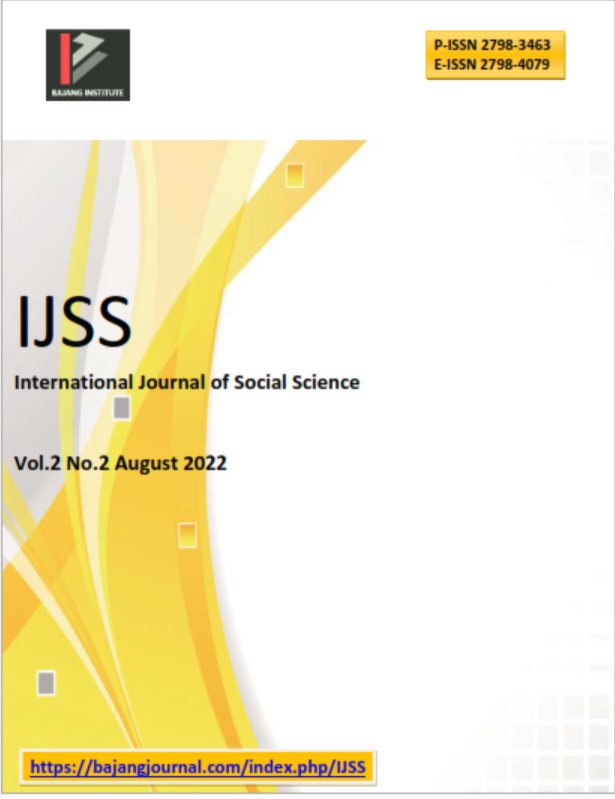SPATIAL STUDY OF SOCIAL FACILITIES PLACEMENT IN DENSE SETTLEMENT USING SPACE SYNTAX ANALYSIS CASE STUDY: BANJAR BUALU, BENOA VILLAGE, BALI
DOI:
https://doi.org/10.53625/ijss.v2i2.3071Keywords:
Settlement Social Facilities Space SyntaxAbstract
Banjar Bualu area is one of the densely populated residential areas in Benoa Village, Bali. The high population must be balanced with the number of social facilities to meet the needs for social, cultural, and economic activities of the community. But in reality, there is still a lack of social facilities built to accommodate the social activities of the local community. Social facilities play a role in providing space for socializing and interaction, so their location must be easily accessible from residential areas. This study aims to provide recommendations for the location of social facilities in the Banjar Bualu residential area, Benoa Village. The method used is a qualitative method with an exploratory approach through space syntax analysis with DepthmapX software, to see integration, connectivity, and also the potentials of space that can be used as social facilities. The method of data collection was carried out by non-participant observation and secondary data related to maps of the road network and buildings from settlements in the Banjar Bualu area.
References
F.I Gede Agus, et al., " Migrasi dan Perubahan Sosial di Nusa Dua 1970-2013,"Jurnal Humanis, Fakultas Ilmu Budaya Unud,” vol. 19, pp. 433-440, May 2017.
Yuliastuti, N., Sukmawati, A. M., & Purwoningsih, P, "Utilization of Social Facilities to Reinforce Social Interaction in Formal Housing,” Archnet-IJAR: International Journal of Architectural Research, Vol.12(1), pp.134–151, 2018.
Ramadhan. T.,Ramadhan.G.,Wijaya.K & Permana. Y.P, “Kajian Spasial Penempatan Fasilitas Sosial Di Permukiman Padat Kota Bandung Menggunakan Analisis Space Syntax Studi Kasus: Wilayah Kelurahan Burangrang, Kecamatan Lengkong, Kota Bandung,” Arcade Jurnal Arsitektur, Vol. 2(2),pp. 66-72, July 2018.
Bafna.S, “Space syntax: A brief introduction to its logic and analytical techniques,” Vol. 35(1),pp. 17-29, 2003.
Jiang B., & Claramunt. C, “Topological analysis of urban street networks,” Environment and Planning B: Planning and design, Vol.31(1),pp. 151-162, 2004.
Mohamad, W. W., & Said, I,. “A review of variables of urban street connectivity for spatial connection,” In IOP Conference Series: Earth and Environmental Science ,Vol. 18, No. 1, p. 012173, February 2014.
Hillier, B., & Hanson, J. The Social Logic of Space. Cambridge University Press, Cambridge, 1984.
Kuswartojo, T. “Mengusik Tata Penyelenggaraan Lingkungan Hidup dan Pemukiman: Mengusik Tata Penyelenggaraan Lingkungan Hidup dan Pemukiman,” Bandung: Kelompok Keahlian Perumahan dan Permukiman ITB, 2010.
Budihardjo, E. “Kota Yang Berkelanjutan.” Bandung: P.T. ALUMNI, 1998.
Chitrakar, R. “Meaning of public space and sense of community: The case of new neighbourhoods in the Kathmandu Valley.” Journal of Architectural Research: ArchNet IJAR,Vol. 10(1),pp. 213–227, 2016.
Zhang, W., & Lawson, G. “Meeting and Greeting : activities in Public Outdoor Spaces Outside High-density Urban Residential Communities,” Journal of urban Design International, Vol.14,pp.207–214, 2009.
Golany, G. Social Planning, New Town Planning, Principles and Practice. New York: John Wiley and Sons Inc, 1976.
Ngui, André, N. & Vanasse, A. “Assessing spatial accessibility to mental health facilities in an urban environment.” Spatial and Spatio- temporal Epidemiology 3, pp.195 – 203, 2012.
Tamin, Ofyar Z. Perencanaan dan Permodelan Transportasi Edisi Kedua. Bandung: Penerbit IT, 2000.
Groat, L., & Wang, D. Architectural Research Methods. Canada: John Wiley and Sons, Inc, 2002.
Warada, W., & Mutiara, D.”Analisis Space Syntax Rumah Susun Berbasis Gang Kampung”. In Simposium Nasional RAPI XII (pp. A59-63). Solo: FT UMS, 2013.
Etikan, I., Musa, S. A., & Alkassim, R. S. “Comparison of Convenience Sampling and Purposive Sampling.” American Journal of Theoretical and Applied Statistics, Vol.5(1),pp. 1–4, 2016.
Adiyanto, J. “Kajian Perubahan Ruang Terbuka pada Kawasan Bersejarah dengan Metode Space Syntax (Studi kasus Kawasan Kampung Kapitan Palembang).” Jurnal Perencanaan Wilayah Dan Kota,Vol.27(2),pp.103. Available: https://doi.org/10.5614/jrcp.2016.27.2.3
Hillier, B. Space is the machine: A Configuration Theory of Architecture. Design Studies (Vol. 18). London: The Press Syndicate of The University of Cambridge, 2007. Available: https://doi.org/10.1016/S0142- 694X(97)89854-7.
Hillier, B., Penn, A., Hanson, J., Grajewski, T., & Xu, J. “Natural Movement: or, Configuration and Attraction in Urban Pedestrian Movement.” Environment and Planning B: Planning and Design,Vol 20,pp. 29–66, 1993.
Hillier, B., Burdett, R., Peponis, J., & Penn, A. Creating Life: Or, Does Architecture Determine Anything? London WCIH OQB, Great Britain: Bartlett School of Architecture and Planning University College London, 1987.

















